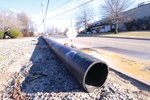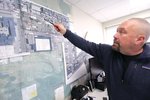By JOHN HOWELL A facsimile of what has been buried and hidden from view for decades has appeared above ground alongside Airport Road, in front of the former Ann & Hope, down Michigan Avenue and next to the sidewalk on Jefferson Boulevard before turning
This item is available in full to subscribers.
We have recently launched a new and improved website. To continue reading, you will need to either log into your subscriber account, or purchase a new subscription.
If you are a current print subscriber, you can set up a free website account by clicking here.
Otherwise, click here to view your options for subscribing.
Please log in to continue |
|


A facsimile of what has been buried and hidden from view for decades has appeared above ground alongside Airport Road, in front of the former Ann & Hope, down Michigan Avenue and next to the sidewalk on Jefferson Boulevard before turning down Service Road. There’s no mistaking that it’s black pipe, a big pipe that snakes across parking lots and ducks beneath drives and Post Road.
It’s a sewer line, and for a short time it will take the place of what was buried in the 1960s. When connected, the pipes make for the bypass to the Airport Interceptor, a major line connecting to the wastewater treatment plant.
The bypass has enabled work on rehabilitating the original pipe that is deteriorating and in danger of collapsing.
Warwick residents got an all too annoying introduction to what collapse means when a section of the Oakland Beach Interceptor – more than 18 feet below Sandy Lane – caved in on Thanksgiving eve 2018. To repair the break and replace a section of pipe meant excavating a section of Sandy Lane that required a detour on Cedar Swamp Road connecting with Range Road behind Mickey Stevens Sports Complex. Repairs took weeks to complete that were followed by an even longer process of addressing the length of the inceptor that was equally deteriorated. The job was completed with a cured in place liner to the existing pipe, which is applied to the Airport Interceptor.
Once a bypass is operational, the work done by Insituform of Charlton, MA, involves inspecting the existing line with cameras, cleaning it and taking precise measurements before installing a sock-like tube of felt-like material saturated with resin. With the introduction of hot water, the tube expands to the sides of the pipe and the hot water serves to activate the curing of the resin that hardens to create a fiberglass lining to the pipe. The lining reinforces the pipe. It is also resistant to the hydrogen disulfide gas (the smell of rotten eggs) that builds up in the pipes when there is inadequate flow. The gas is a factor in the deterioration of the pipes.
The Airport Interceptor bypass is more than a mile long.
There could be one snag to the job that hinges on Amtrak.
The interceptor crosses under Amtrak at Kentucky Avenue. To bypass that section of pipe, the plan is to run a bypass parallel to the railroad to the Lincoln Avenue underpass and from there to the bypass alongside Jefferson Boulevard, explained Mathew Solitro, collection system and construction manager. So far Amtrak hasn’t signed off on the plan even though the Sewer Authority submitted plans last spring.
Since the restoration of pipes is done in sections, the bypass needn’t be fully operational for the work to begin.
Initially the work was to have been completed under a single contract, but the Sewer Authority broke it down into two and possibly three.
The first phase of the work at $1.2 million that is nearly fully completed runs from the fire station next to Veterans Middle School across Sandy Lane at Armory and then in Rhode Island parlance to where the geodesic dome used to be on Airport Road. The second contract at $2.755 million addresses the line from the dome to the treatment plant said WSA director Betty Anne Rogers. Solitro said nearly half of the second contract from Balise Auto on Jefferson Boulevard to the plant is completed and work from the dome to Kentucky is slated to start Feb. 7. A third contract budgeted at $1 million may be needed for section of pipe that runs under the railroad depending on Amtrak approval of the Lincoln Avenue underpass as the site for the bypass.
Rogers said the Oakland Beach and Airport Interceptors are critical links to the city’s sewer system and they were on the top of the list for restoration. There’s more work to follow, however, including forced main lines at Cedar Swamp and Oakland Beach that are presently in design.
Rogers said the authority has identified ten years of maintenance and replacement projects that in addition to pipes include pumping stations, circulator pumps at the treatment as well as improved communications and process controls at the plant.
Rogers said the authority has completed a financial review of operations as well as a five-year rate study.
“We can do all these projects without increasing rates,” she said.
Comments
No comments on this item Please log in to comment by clicking here